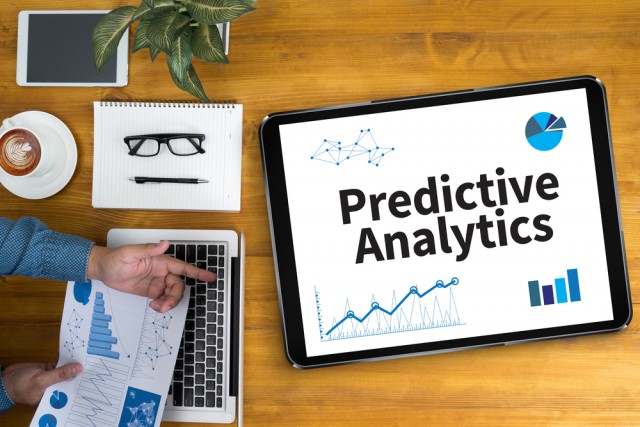
Salesforce reveals AI-powered Einstein Analytics
Salesforce has revealed the launch of its most advanced CRM analytics platform yet.
Called Einstein Analytics, this platform leverages artificial intelligence to the analytics workflow, allowing users to automatically create CRM insights. The AI will also be able to recommend actions which improve customer service and boost sales, as well as helping optimize marketing campaigns.

MicroStrategy enterprise analytics platform comes to AWS
Businesses are collecting more information than ever before, and they need a reliable and accessible way of analyzing it.
Enterprise analytics specialist MicroStrategy is making its business intelligence platform available on AWS, giving users an on-demand solution that can be up and running fast.

New free plugin filters bot data from Google Analytics
Google's own bot filtering catches only a small percentage of the bot traffic that hits most sites, leading to traffic analysis data being skewed.
Bot detection specialist Distil Networks is launching a free tool designed to remove the bad data created by bots.

Analytics alone aren't enough to guide your business
Everywhere you look, businesses of all shapes and sizes are looking to transform themselves into digital businesses. This digital transformation tidal wave is often predicated on building a more robust, data-driven organization.
Executives want to make more informed, more strategic decisions, and see analytics technologies, from big data to predictive analytics to good old fashioned business intelligence, as the silver bullet to do so. It’s no secret that businesses are buying in big. Worldwide revenues for big data and business analytics are expected to grow 50 percent, up from $122 billion in 2015 to $187 billion in 2019, according to research from IDC.

Breach analytics platform speeds up incident response
It's increasingly said by experts that data breaches are now a matter of when rather than if. Being able to respond quickly is therefore vital for companies to minimize damage and disruption.
Cybersecurity solutions and breach analytics cloud platform Eastwind Networks is launching an enhanced Breach Analytics Cloud platform to provide complete visibility across the entire attack surface.

What we learned from predicting the 2016 US presidential election
As we approach the end of 2016, what feels like a very long election cycle in the US is finally coming to an end, complete with what, for many, was a surprising conclusion based on the pre-election polls (or, more accurately, how those polls were interpreted). Given the pre-election polls and the subsequent critical press coverage, it is natural to wonder whether the data presented in various 2016 presidential election predictions had some "issues".
Four years ago we were interested in how data analytics could be used in pre-election polling to make it statistically more accurate so we created an analytic app that was based on Gallup polling data to predict the winner (Barack Obama or Mitt Romney) of the election. It was a simpler application, but we got some accurate results, predicting 85 percent of the counties correctly.

Modeling and analytics and their role in business [Q&A]
Businesses are collecting more data about their operations and their customers than ever before. But data in itself is only part of the story. For it to be useful it's necessary to spot patterns and gain insights.
At this point most businesses turn to analytics, but this can only tell you what's happened in the past. To predict future trends means using algorithms to build models of what may be complex systems.

What you need to know about predictive analytics
In an era when data is seen as an increasingly valuable commodity, the tools and techniques used to analyze that data gain extra importance.
Historically analysis, even using computers, has been something of a labor intensive task because the raw data needed to be verified and complex models built to process it. But due to the growth of machine learning and data mining techniques we’re now seeing an increase in predictive analysis where machines can take historical and current information and apply it to a model to predict future trends.

How can form analytics help businesses increase conversions?
A form is one of the most important elements on many websites because it is where conversions happen, leads are created, and relationships begin.
According to MarketingCharts, Lead Gen forms have an average conversion rate of just 17 percent. As dismal as these numbers are, the good news lies in the immense opportunity left by the 83 percent of visitors who do not convert on forms -- and the data-driven solution to help win over more of them.

The analytics machine: Why contact center technology is changing the customer experience
For a long time, the contact center was nothing more than a place where customer complaints went to die. An agent’s objective was to simply note the issue and try to resolve it as quickly as possible, and metrics were nothing more than call duration and first call resolution. However, technology has changed the role of the contact center, and analytics are evolving the department into a hub of rich customer insights. Every day, agents interact with hundreds, if not thousands, of customers, and they’re hearing what they want, don’t want, or need -- right from customers’ mouths!
By feeding this information into analytics technology, contact centers can integrate into every touch point along the customer journey and fundamentally change the customer experience.

Three areas every business can apply analytics to in order to avoid regulatory trouble
Every business leader understands the importance of regulatory compliance and is aware of how dire the consequences can be if an organization is found to be out of compliance. With stringent regulations enforcing compliance, such as HIPAA or Sarbanes-Oxley, it’s imperative that companies maintain strict procedures to avoid facing potential fines or lawsuits, and risking consumer distrust. Any one of these factors can seriously threaten the long-term viability of the brand.
However, implementing the right infrastructure and policies to adhere to these requirements is a challenge that every company faces. With the hundreds, if not thousands, of customer interactions and exchanges of data that happen every day, it only takes one slip or lapse in protocol to put the entire organization at risk. Now, business leaders are turning to analytics solutions to mitigate risk and remove uncertainty. Whether it’s the contact center, data center, or online social communities, analytics are proving a powerful tool to help keep businesses out of regulatory hot water.

Failed projects prompt companies to move to cloud analytics
While there is huge interest in data analytics among the business community many organizations are struggling with failed projects according to a new study which reveals 88 percent of respondents have suffered failures with recent initiatives.
Reasons for the failure of analytics projects include low end-user adoption, projects going over budget, systems not providing the analytics users were expecting, and too many initiatives evolving into 'zombie' projects that were almost completed but not ready for end-users.

Analytics and data are the most sought-after IT job skills
Data and analytics are some of the most important new skills you, as an employee, can have today. This is according to Alteryx, whose new report dives into the most important skills and competencies in the workforce today. That being said, data and analytics have surpassed some interesting skills, like multilingualism.
Knowing a second language isn’t really that important any more, even though a 2014 report suggested otherwise. The Alteryx report, entitled The Business Grammar Report, also says data is no longer "confined to the IT department or technical specialists". Just 15 percent of UK businesses are still doing it the old fashioned way while almost a third (31 percent) are empowering their employees with self-service analytics tools.

Salesforce acquires data analytics startup BeyondCore
Salesforce has announced it is buying data analytics startup BeyondCore. In a tweet posted earlier this week, Marc Benioff says: "I am thrilled announce @Salesforce has acquired @beyondcoreinc to enhance the AI capabilities of Analytics Cloud".
Financial details of the acquisition were not disclosed, but we do know that BeyondCore will integrate into Saleforce’s Analytics Cloud, and will leverage its AI knowledge.

How data APIs accelerate creation of analytics apps
One way to access data efficiently and accelerate the development and deployment of analytics apps is to build an API. APIs are a natural way to access data, whether it be personalization scores for web content or a service to assess the risk of a part failing.
There are a number of benefits to using an API for data access. First, it restricts the user to efficient requests. Google Analytics is a prime example. A query API gives you access to the rich data in your Google Analytics instance. While the API is fairly flexible, it allows Google to more accurately describe the types of queries that can be performed efficiently.
